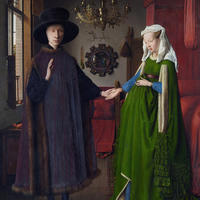More about Giorgio Vasari
- All
- Info
- Shop
Works by Giorgio Vasari

Contributor
Girogio Vasari was a man of many talents.
A true polymath. He could write, paint, architect, hold administrative office. The list goes on. He was in “a jack of all trades, master of none” kind of situation. His paintings were only popular when he was alive. He wasn’t bad at it; he just wasn’t as good as the best of his contemporaries. Nevertheless, Vasari made various contributions to 16th century Italian art. The most important was a book, the first of its kind. It was called "The Lives of the Most Excellent Painters, Sculptors, and Architects."
Vasari was born in Arezzo, a small town in Tuscany, in 1511. It appears his talents were recognised fairly early. When he was eight, a famous stained glass artist came to town. Guglielmo da Marsiglia, originally from France, was in Arezzo to paint three windows for the Cathedral. Vasari quickly became his pupil. While other kids were playing outside, little Giorgio would sit in churches studying the paintings.
When Giorgio turned 16, he went to Florence to study with Andrea Del Sarto. At the time, all this must’ve been really expensive for little Giorgio. Lucky for him, other people, richer people, got wind of him. Behind the most successful artists in Renaissance Italy was a kooky Medici gangster.
In 1527, the Medici family was booted out of Florence. Vasari followed. In 1532, Alessandro de Medici re-acquired Florence. Vasari continued to paint for Alessandro until the Medici Duke was killed in 1537. Maybe Vasari freaked, but he left the court immediately after. He didn’t go back to the court until 1554.
Cosimo I Medici was elected the next Duke of Florence. This guy was a little paranoid and insecure about his position in the Medici family. His mother was Alessandro’s cousin. They belonged to the second branch of the illustrious family and Cosimo wasn’t proud of it. He was known to be a suspicious man, trusting only those he knew. Vasari had to dedicate an entire book to the guy to get his attention. Clearly, flattery was the way to go with Cosimo. "The Lives" was published in 1550. From 1554, the offers from the Medici fam started pouring in. Vasari mostly built corridors and passages between important buildings. Not a small job, but not the main job.
The book made Vasari a legend. We can’t talk about Art History with capital letters without talking about him. Heck, we can’t talk about the Renaissance without talking about him. He didn’t coin the term, but he did make it popular. The book is riddled with historical inaccuracies and is clearly Medici propaganda, writing into history only Florentine artists. Vasari subsequently wrote a few more editions, including painters from other parts of the country. Giorgio may have been kissing Medici ass, but he was only doing it for art, for us, for posterity. Vasari has waded through angry mob’s to save Michelangelo’s David (his arm was severed during a riot). He may even have saved a Da Vinci from total destruction by hiding it behind one of his own murals. Not bad at all.
Disclaimer: Some of the links are amazon affiliate links, meaning that at no additional cost to you, by clicking through and making a purchase, you will also be contributing to the growth of Sartle.
Sources
- "Giorgio Vasari Biography, Life & Quotes." The Art Story. Accessed July 31, 2019. https://www.theartstory.org/artist/vasari-giorgio/life-and-legacy/.
- Shau, Kevin. "Branding the Renaissance - Giorgio Vasari." Medium. November 26, 2018. Accessed July 31, 2019. https://medium.com/@kevinshau/branding-the-renaissance-giorgio-vasari-f….
- Art, National Gallery of. "Giorgio Vasari's Description of the Medici "academy"." Italian Renaissance Learning Resources. Accessed July 31, 2019. http://www.italianrenaissanceresources.com/units/unit-3/sub-page-03/gio…
- "Michelangelo & The Medici." International Opulence Magazine. Accessed July 31, 2019. http://www.internationalopulence.com/michelangelo-the-medici/.
- "Giorgio Vasari." PBS. Accessed July 31, 2019. https://www.pbs.org/empires/medici/renaissance/vasari.html.
- "Giorgio Vasari (1511-1574)." Giorgio Vasari: Italian Mannerist Painter, Biographer. Accessed July 31, 2019. http://www.visual-arts-cork.com/old-masters/giorgio-vasari.htm.
- Solomon, Deborah. "How Giorgio Vasari Invented Art History as We Know It." The New York Times. December 01, 2017. Accessed July 31, 2019. https://www.nytimes.com/2017/12/01/books/review/collector-of-lives-gior….
Featured Content
Here is what Wikipedia says about Giorgio Vasari
Giorgio Vasari (30 July 1511 – 27 June 1574) was an Italian Renaissance painter, architect, art historian, and biographer known for his work Lives of the Most Excellent Painters, Sculptors, and Architects, considered the ideological foundation of Western art-historical writing, and still much cited in modern biographies of the many Italian Renaissance artists he covers, including Leonardo da Vinci and Michelangelo, although he is since regarded as including many factual errors, especially when covering artists from before he was born.
Vasari was a Mannerist painter highly regarded both as a painter and architect in his day but rather less so in later centuries. He was effectively what would later be called the minister of culture to the Medici court in Florence, and the Lives promoted, with enduring success, the idea of Florentine superiority in the visual arts.
Vasari designed the Tomb of Michelangelo, his hero, in the Basilica of Santa Croce, Florence, that was completed in 1578. Based on Vasari's text in print about Giotto's new manner of painting as a rinascita (rebirth), author Jules Michelet, in his Histoire de France (1835), suggested the adoption of Vasari's concept, using the term Renaissance (from French) to distinguish the cultural change. The term was adopted thereafter in historiography and remains in use.
Check out the full Wikipedia article about Giorgio Vasari
















